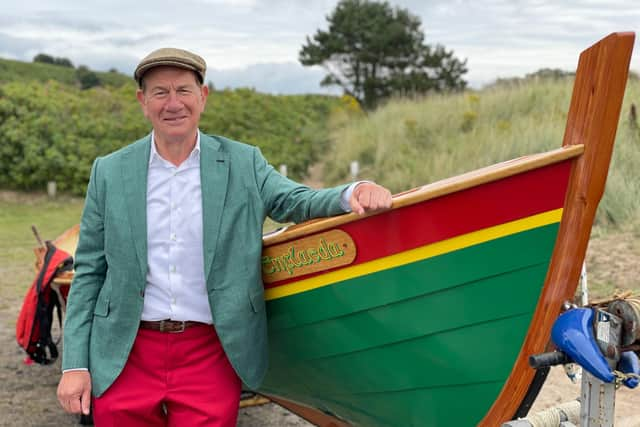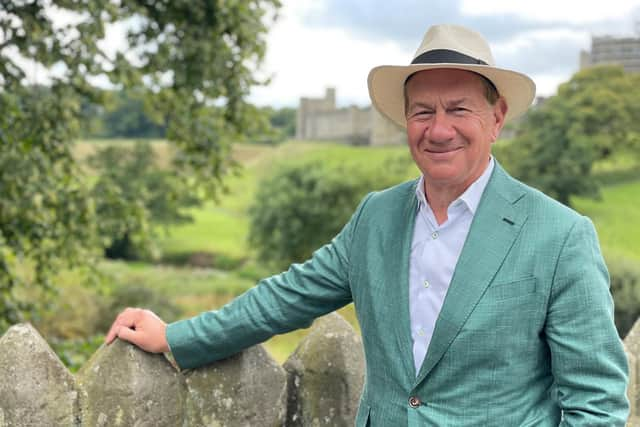Northumberland set to feature on TV's Great Coastal Railway Journeys
and live on Freeview channel 276
Five episodes covering ‘Tynemouth to Berwick’ will be broadcast from Monday, February 7 at 6.30pm.
Presenter Michael Portillo travels on board the Metro, the East Coast Mainline and the Tyne Valley line to marvel at the scenery and admire the architectural and engineering legacy of the railways in the region where they were invented.
Episode 1 (Monday): Newcastle to Bardon Mill


Advertisement
Hide AdAdvertisement
Hide AdIn Tynemouth, Michael discovers one of the most treacherous coastlines in Britain and hears of a 19th century tragedy at sea that inspired 140 local men to set up a coastal rescue service. The Tynemouth Volunteer Life Brigade trained rescuers to operate an ingenious apparatus called a breeches buoy from the shore. Michael finds out how it works and enjoys a pint and a sea shanty with long-serving volunteers.
At Long Sands beach, Michael rolls up his sleeves to help volunteers caring for sick and injured seals at the Tynemouth Aquarium Seal Hospital. A young pup called Gandalf needs to have his temperature taken.
From Newcastle Central, Michael boards The Passage to India train service, a curry express, which takes him 20 miles along the Tyne Valley line to the station house at Corbridge, now an Indian restaurant.
Back on the Tyne Valley line, Michael ‘s train traces the course of the mighty Hadrian’s Wall. At Bardon Mill, he discovers some of the richest Roman archaeological sites in Britain at Vindolanda. Michael joins volunteer excavators to hear about some of their intriguing finds.


Episode 2 (Tuesday): Newcastle to Lynemouth
Advertisement
Hide AdAdvertisement
Hide AdHeading north from Newcastle, Michael discovers one of Newcastle’s trendiest hotspots, Ouseburn, and is intrigued to hear of its part in Newcastle’s early industrial development.
En route, Michael travels through the huge Northumberland coalfield. At Cramlington, he alights to visit an extraordinary work of landform art made from the spoil of a coalmine, the vast Northumberlandia, known as the Lady of the North.
Next stop is the former coal port of Blyth. On the historic quayside Michael enjoys a hearty sea shanty and learns about an intrepid former townsman, Captain William Smith, who, in 1819, discovered the Antarctic.
Michael meets a group of young people, who have been inspired by the captain’s story to restore a Scottish Herring drifter, called a Zulu, with the Blyth Tall Ships Charity.
Advertisement
Hide AdAdvertisement
Hide AdAt Bedlington, Michael hunts down a lost railway, whose services began in 1850 but closed to passengers in 1964 following the Beeching Report. But the 18-mile coastal Blyth and Tyne Railway is rising from the ashes and test trains are already on the track.
Lynemouth Power Station once used coal to produce electricity but today has switched to biomass. Michael boards a half-kilometre long freight train loaded with wood pellets bound for the power station. He hears from the train driver and the fuel manager at Lynemouth how the decline of coal has affected their working lives and the region in which they live and learns of the part rail is playing in saving carbon.
Episode 3 (Wednesday): Morpeth to Amble
Michael Portillo explores the wild and rugged coastline of Northumberland by rail. He begins today in Morpeth, where he finds an historic collection of Northumbrian bagpipes and discovers how difficult they are to play.
The East Coast mainline delivers Michael to Widdrington and its long sandy bay, where a beachcombing blacksmith finds treasures to inspire artwork in steel. Michael helps to put the finishing touches on a metal seaweed design.
Advertisement
Hide AdAdvertisement
Hide AdAt Rothbury, Michael visits Britain’s first “smart home” - a gadget-filled, Victorian mansion built by a wealthy industrialist and inventor, William Armstrong. Cragside clings to the side of a mountain and is full of 19th century mod cons including an early dishwasher and a water-powered roasting spit, central heating and hydroelectricity.
Heading back to the sea, Michael reaches the mouth of the River Coquet and the fishing port of Amble, home to one of the largest fleets of inshore fishing boats on this coast. An innovative scheme to promote ugly fish challenges his taste buds. Can he resist a red gurnard risotto?
Episode 4 (Thursday: Alnmouth to Bamburgh
Michael Portillo travels the length of the magnificent Northumbrian coastline with its glorious beaches and grandiose castles.
In the village of Alnmouth he takes to the waves in a traditional skiff built by dedicated members of the Alnmouth Coastal Rowing Club. They’re training to compete in the World Championships in a boat they built themselves, based on a design from Fair Isle. Michael has to learn fast to stay afloat.
Advertisement
Hide AdAdvertisement
Hide AdThe Aln Valley heritage railway conveys Michael to Alnwick, crossing a 170-year-old viaduct built by Robert Stephenson. From the historic cobbled town with its imposing castle Michael heads for the beach at Boulmer to hear about threats to this low-lying coastline and efforts to protect it from sea erosion and tidal surges.
Next stop for Michael is Chathill, which serves the 19th century port of Seahouses, from where boats depart for the Farne islands. Along this rocky coastline, Michael heads for the Olde Ship Inn to discover a fascinating map, which charts the wrecks of many ships.
The mighty Bamburgh Castle, icon of Northumberland, is Michael’s last destination today. Once the seat Northumbrian kings, the castle building was begun by the Normans and since the late 19th century has been in the hands of the Armstrong family. Michael meets the castle’s current keeper to hear about its history and admire its magnificent King’s Hall.
Episode 5 (Friday): Farne Islands to Berwick-upon-Tweed
Michael Portillo’s railway journey along the glorious coast of Northumberland continues towards the Farne Islands, takes in the holy island of Lindisfarne, and finishes in England’s northernmost town, Berwick-upon-Tweed.
Advertisement
Hide AdAdvertisement
Hide AdOn the largest of the Farne Islands, Inner Farne, Michael pitches in to help rangers clear a toxic plant which is invading the island. It’s so prolific it’s threatening native plants on which seabirds depend for nesting.
From the mainland, Michael sets off on a two-mile pilgrimage along a single-track causeway, which twice a day is covered by the North Sea. His destination is the holy island of Lindisfarne. Michael discovers the island was chosen in the 7th century by St Aidan as the site for a monastery. Northumbria’s patron saint, St Cuthbert, later became bishop there. The vicar of the island today shows Michael a full- sized reproduction of the beautifully illuminated Lindisfarne Gospels, the originals of which are held in the British Museum.
Back on the East Coast Mainline, Michael hugs the North Sea coast, crossing the River Tweed on Robert Stephenson’s Royal Border Bridge, to reach Berwick-upon-Tweed. Struck by the variety of accents and dialects in the northeast, Michael learns what distinguishes a Geordie from a Smoggie.
Only two and a half miles from Scotland, Berwick-upon-Tweed has a turbulent past and an intriguing custom, dating back to the 15th century. Michael begs permission from the town’s mayor to join horses and riders in a ceremony to mark the border between Scotland and England along a line agreed in 1438.